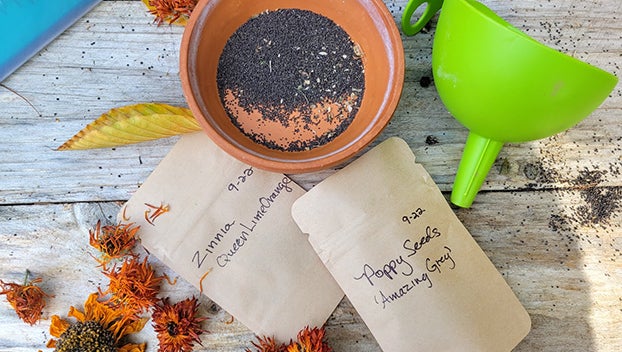MASTER GARDENER — The correct way to save seeds (Part 2 of 2)
Published 12:14 am Wednesday, June 28, 2023

- Successful seed savers always ensure seeds are thoroughly “air” dried before storing seeds. Removal of moisture discourages mold and mildew formation during storage increasing the viability of seeds. (Alamanac.com)
|
Getting your Trinity Audio player ready...
|
Gardeners, another intensely ‘hot’ week is in store with daytime temperatures soaring, ‘flirting’ with triple digits throughout most of our SETX areas.
It’s clear summers arrived with a vengeance and in ‘full swing’, so be mindful when working outdoors and plan accordingly. Start garden tasks early in the morning or late in the evening, take numerous, frequent breaks in sheltered areas.
Replace fluids lost due to exertion by drinking plenty of water to maintain hydration and keep a small towel nearby, you’ll be needing it (if you’re working outside or not)! Let’s ‘dig’ into the 2nd part of our discussion on how to harvest and save seeds. Last week we discussed the basics (seed types).
Now, let’s review 6 steps in seed saving to ensure viable seed for future use, let me begin by stating seeds must be dry, completely dry!
The process of seed saving varies slightly depending upon plant species, but these are the general steps to follow for saving seeds:
Annual Plants — Save seeds from plants which produce seeds quickly, i.e., beans, peas, pak choi, tatsoi, peppers, eggplant, tomatoes, radish, and lettuce. Plants falling into the annual plant category have a single life cycle-start to finish within one season. Biennials and most perennials will not produce seeds until their 2nd growing season (2 years).
Cross-pollination — Open-pollinated plants must be isolated from other varieties of the same type of plant because if cross-pollination occurs between open-pollinated plants and another variety within the same species, seeds produced will demonstrate different characteristics and may not retain the desired traits. This is easily managed by planting varieties at a distance apart from each other. Note: tomatoes, peppers, lettuce, radish, beans, and peas are self-pollinating plants having little chance of cross-pollination.
Seed Maturity — Before harvesting seeds, ensure the seeds are mature or they will not germinate. Harvest ‘dry’ seeds, such as beans and peas once the seeds are hard and dry inside the pod. They are ready to harvest if they rattle inside the seed pod when shaken. ‘Wet’ seeds, such as tomatoes, squash, peppers, and eggplant: wait until overripe before harvesting the seeds. Personally, I find it best to mark fruit or vegetables intended for seed harvesting, allowing them to remain ‘on the vine’ or plant until fully mature.
Dry Thoroughly — It doesn’t matter if collecting ‘dry’ or ‘wet’ seeds, what is important is that the seeds are thoroughly dried after harvesting. Open the seed pods of beans and peas, placing the seeds onto a paper towel in a single layer. Keep the seeds out of direct sunlight, in a well-ventilated area for 3 to 4 weeks or longer until dry.
Fermented Seeds — Tomato seeds benefit from fermentation before drying and produce more viable seeds, since fermenting tomato seeds breaks down compounds on the seeds exterior which hinder germination. Choose the most robust fruit from the healthiest plants, then slice them in half, removing ‘pulp’ (gelatinous membrane) and seeds and placing into a jar. Add 3-inches of water to pulp/seed mixture, gently swirl the jar, then cover the jar with a towel. A surface layer of mold will form in 4 to 5 days, simply remove the mold, and rinse the seeds through a fine strainer. Place the seed onto a layer of paper towel and allow the seeds to dry for 6 to 7 days before storing. I use the ‘fingernail’ test to determine if the seeds are dry. Press a fingernail into one seed, if an indentation is made on the seed, continue drying the seeds.
Dark Storage — Remember dark, cool, and dry! Seeds are best kept in airtight containers, such as a glass jar, or a pill bottle. Placing the container in a dark, cool, dry place with minimal changes in humidity is key for guaranteeing seeds viability. For long term storage, I store seeds in the freezer. Some seeds can last for many years when stored properly, while others may not. It’s best to research seed storage recommendations for the specific plant species to make sure they won’t expire before you plant them. Always, always, always label seed containers with plant type, variety, date harvested, and date placed into storage. Seeds stored in the freezer must be allowed to warm to room temperature before opening to stop condensation from forming on the seeds.
So long for now fellow gardeners, let’s go out and grow ourselves a greener, more sustainable world, one plant at a time. Thank you for your recent questions; I’ve enjoyed answering each one.
John Green is Texas Certified Master Gardener with Orange County Master Gardeners. If you have gardening questions, email jongreene57@gmail.com or phone the Orange County Master Gardeners Helpline at 409-882-7010.





